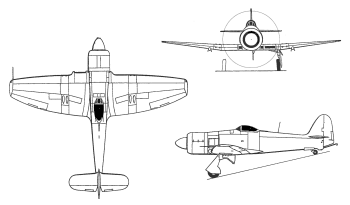



Yet another aircraft from famed designer Sydney Camm, the Hawker Sea Fury was an attempt to create a lighter version of the Tempest aided in no small part due to the accidental capture of a German Fw 190 in Britain. The resulting design had much shorter wings and a fully monocoque (lacking steel tubes) fuselage and was one of the fastest single piston-engined aircraft ever. Unfortunately, the RAF cancelled the full order at the end of the war, fortunately the Royal Navy found interest in a navalized version which became one of the principal post-war carrier fighters of the fleet, albeit the last piston-engined type. Both RAF and RAAF Sea Furies saw extensive action during the Korean War (aircraft from No. 802 Squadron flying from HMS Ocean even downed a MiG-15 jet) and it was also exported to a total of 10 countries which included license-production in the Netherlands by Fokker.
First flight of the original Fury prototype took place on 1 September 1944 but were cancelled at the end of World War II. The navalized version first flew on 21 February 1945 and entered service as the Sea Fury F.10 shorly after the war ended; these featured four-bladed propellers which were later increased to five in the FB.11 which also had provisions for external ordinance. Lastly, a tandem two-seat trainer was the T.20. Export versions were known as the F.50 and FB.60.
Preceded by:
NoneSucceeded by:
None | |
| Design | Sea Fury FB.11 |
| Type | Fighter |
| Year | 1948 |
| Crew | 1 |
| Dimensions | |
| Length | 10.57 m |
| Height | 4.826 m |
| Wing Span | 11.71 m |
| Wing Area | n/a |
| Weight | |
| Empty | 4,191 kg |
| Maximum | 6,645 kg |
| Wing Loading | 255.5 kg/m² |
| Performance | |
| Speed | 740 km/h |
| Ceiling | 10,912 m |
| Range | 1,126-1,674 km |
| Powerplant | |
| Engine | 1 x Centaurus XVIII Bristol 1,678 kW |
| Thrust/Weight | 0.49 |
| Armament | |
| Guns | 4 x 20-mmHispano Mk. V |
| Payload | 907 kg |
| Hardpoints | 2 |
| Production | |
| Built | 615 |
| Total | 932 |